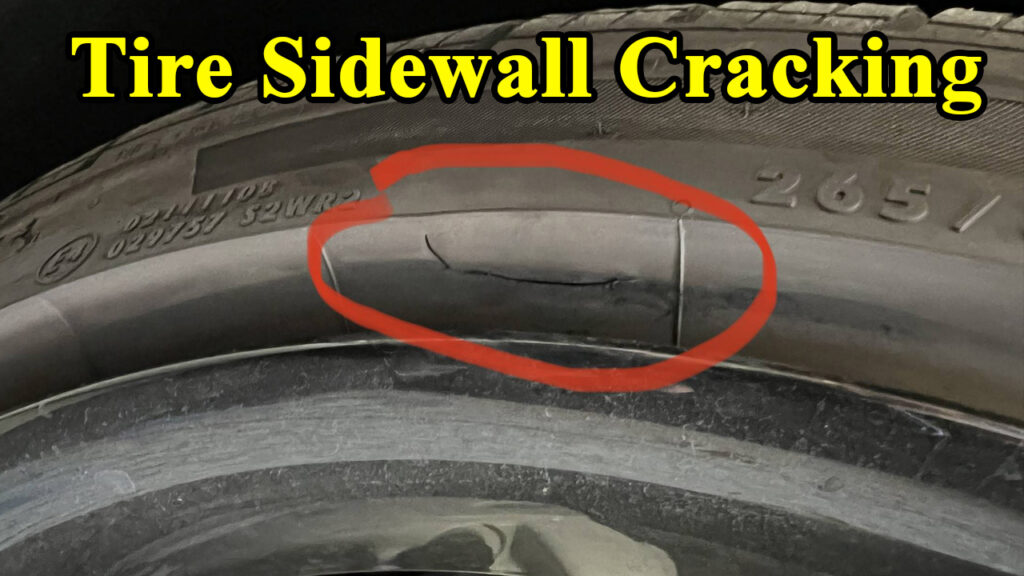You pull into your driveway after a long day, perhaps during a quick stop at the car wash, or maybe while just checking the air pressure. As your eyes scan the tires, you might notice something unsettling: a fine network of lines, like tiny spiderwebs, spreading across the rubber sidewall. This is tire sidewall cracking, often referred to as “crazing,” “weather checking,” or even “dry rot.” It’s a common sight, but one that often goes misunderstood and, more dangerously, ignored.
Tires are the sole contact points between your vehicle and the road, making them paramount to your safety and your car’s performance. While tread depth usually gets all the attention, the integrity of the sidewall is just as critical. Ignoring those seemingly innocuous cracks can lead to a host of problems, from diminished handling to, in extreme cases, a catastrophic blowout.
In this in-depth guide, we’ll peel back the layers of tire sidewall cracking. We’ll explore exactly what it is, uncover its root causes, illuminate the hidden dangers it poses, and provide practical advice on how to identify, prevent, and address it. Our goal is to empower you with the knowledge to keep your tires healthy and your drives safe, making sure you’re not caught off guard by this silent threat.
What Exactly Is Tire Sidewall Cracking? A Closer Look
At its core, tire sidewall cracking is the visible degradation of the rubber compound that forms the side of your tire. Imagine your skin getting dry and wrinkled with age or a piece of old leather developing fine lines – that’s a good analogy for what happens to tire rubber. These cracks can range from shallow, almost imperceptible surface lines (often called “crazing”) to deeper, more pronounced fissures that signal a significant breakdown of the tire’s structure.
The sidewall is the part of the tire that connects the tread to the wheel rim. It’s designed to be flexible, allowing the tire to absorb impacts and adapt to road conditions. However, this flexibility also makes it susceptible to environmental factors and stresses that, over time, can cause the rubber to lose its elasticity and develop these tell-tale cracks. While some minor, superficial cracks might be purely cosmetic, deeper and more widespread cracking indicates that the tire’s rubber is losing its integrity, weakening its ability to perform its crucial function.
The Culprits: Why Do Tire Sidewalls Crack?
Tire sidewall cracking isn’t usually the result of a single factor but rather a combination of environmental exposures, age, and maintenance habits. Understanding these culprits is the first step in prevention.
-
UV Radiation (Sunlight): The Primary Enemy. Just like prolonged sun exposure can damage your skin, ultraviolet (UV) rays from the sun are a tire’s arch-nemesis. UV radiation breaks down the chemical bonds in the rubber compounds, leading to a loss of flexibility and the eventual formation of cracks. This is why vehicles parked outdoors, especially in sunny climates like ours in Cheney, Kansas, often show more pronounced cracking than those kept in garages.
-
Ozone Exposure: An Invisible Assailant. Ozone, a gas naturally present in the atmosphere and also produced by electrical motors and generators, is highly reactive. It attacks the rubber polymers, causing them to become brittle and crack. Tire manufacturers incorporate “antiozonants” into the rubber compound to migrate to the surface and provide a protective layer, but over time, or with insufficient tire use (which prevents the antiozonants from being replenished at the surface), this protection can diminish.
-
Age of the Tire: The Inevitable March of Time. Even if a tire has minimal mileage or appears to have plenty of tread, age is a critical factor. Rubber degrades over time through a process called thermo-oxidative aging, a combination of heat and oxygen exposure. Most tire manufacturers and safety experts recommend replacing tires that are six years old or older, regardless of their apparent condition or remaining tread. This is a crucial “important value” to remember: the DOT date code on your tire tells you its manufacturing week and year, and it’s a non-negotiable indicator of its true age.
-
Improper Inflation: The Silent Stressor. Both under-inflation and over-inflation can contribute to sidewall cracking. Under-inflated tires flex excessively, generating more heat and putting undue stress on the sidewall, accelerating rubber degradation. Over-inflated tires, while seemingly firm, can also become more rigid and less able to absorb impacts, leading to stress cracks, especially if hitting potholes or curbs.
-
Chemical Exposure: The Harmful Handful. Road salts, oil, grease, and especially certain harsh, petroleum-based tire dressings can strip away the rubber’s protective elements and accelerate cracking. Be wary of tire shine products that leave a greasy, shiny residue; many of these can do more harm than good in the long run.
-
Extreme Temperatures: Hot and Cold Stress. Rapid fluctuations between hot and cold temperatures, or prolonged exposure to extreme heat, can stress the rubber and contribute to cracking. Our Kansas summers, with their intense heat, can be particularly hard on tires.
-
Manufacturing Defects (Rare but Possible): While uncommon with reputable brands, sometimes a defect in the tire’s compounding or construction can lead to premature cracking. However, this is usually covered under warranty.
-
Driving Habits: Repeatedly rubbing against curbs or driving aggressively over potholes can cause localized stress and damage to the sidewall, which may manifest as cracks.
The Hidden Dangers: Why You Shouldn’t Ignore Sidewall Cracks
It’s tempting to dismiss minor sidewall cracks as merely cosmetic, but doing so can be a dangerous oversight. These seemingly small imperfections can have significant implications for your safety and your vehicle’s performance.
-
Compromised Structural Integrity: The sidewall is a key structural component of the tire. It contains layers of cord (often polyester, nylon, or steel) embedded in the rubber, which give the tire its strength and shape. When cracks penetrate these layers, they weaken the tire’s overall structure. This weakening can lead to the tire being unable to withstand normal driving pressures and forces.
-
Increased Risk of Blowouts: This is the most severe and immediate danger. A deeply cracked sidewall is a ticking time bomb. Under the constant stress of driving, especially at highway speeds, a compromised sidewall can suddenly give way, leading to a rapid loss of air pressure – a blowout. Losing control of your vehicle at high speeds due to a blowout can have catastrophic consequences, leading to serious accidents, injuries, or even fatalities. I remember a client right here in Cheney, Kansas, who came into my shop with what he thought were just “cosmetic” cracks. Upon closer inspection, the cracks were deep enough to expose the tire’s internal cords. We explained the immediate danger; he replaced them on the spot. He later told me how grateful he was, realizing how close he’d come to a major incident, especially with our hot Kansas summers putting extra strain on tires.
-
Reduced Tire Lifespan: Even if a blowout doesn’t occur, sidewall cracks signify that the tire is degrading. This means its effective lifespan is significantly shortened, forcing you to replace tires prematurely.
-
Decreased Handling and Safety: A tire with compromised sidewall integrity won’t perform as intended. It can affect steering response, braking efficiency, and overall vehicle stability, especially in emergency maneuvers or adverse weather conditions.
How to Identify and Assess Sidewall Cracks: A Practical Guide
Regularly inspecting your tires should be part of your vehicle maintenance routine. It’s easy to do and takes only a few minutes.
-
Visual Inspection:
- Clean the Tires: Wash off any dirt or brake dust to get a clear view.
- Examine the Entire Sidewall: Slowly roll your car forward or backward to inspect the entire circumference of each tire.
- Look for Fine Lines and Deeper Fissures: Pay attention to the areas closest to the tread and near the rim. Are the cracks superficial, like hairline wrinkles, or do they appear deeper and more extensive?
- Check for Discoloration: Cracking is often accompanied by a brownish discoloration, which is the anti-ozonant chemicals blooming to the surface as the rubber degrades.
-
The “Pinch Test”: Gently flex the sidewall with your fingers. If the cracks open up significantly or you can see the internal cords (the fabric or steel strands within the rubber), it’s a strong indication of structural damage.
-
Check the DOT Date Code: Every tire has a DOT (Department of Transportation) code stamped on its sidewall. The last four digits of this code indicate the week and year the tire was manufactured. For example, “2223” means the tire was made in the 22nd week of 2023. If your tires are six years old or older, regardless of their appearance, it’s highly recommended to replace them.
-
When to Seek Professional Advice: If you’re unsure about the severity of the cracks, or if they appear deep, long, or widespread, it’s always best to have them inspected by a qualified tire professional. They can accurately assess the tire’s internal integrity and advise on whether replacement is necessary. Remember, patching a sidewall crack is generally NOT recommended or considered safe by tire manufacturers due to the stresses placed on that part of the tire.
Prevention is Key: Extending the Life of Your Tires
While some degradation is inevitable, proactive maintenance can significantly extend the life of your tires and prevent premature sidewall cracking.
-
Proper Tire Inflation: Your First Line of Defense. This cannot be stressed enough. Check your tire pressure regularly (at least once a month and before long trips) using a reliable gauge. Always refer to your vehicle’s owner’s manual or the sticker on the driver’s side door jamb for the recommended tire pressure, not the maximum pressure listed on the tire sidewall. Correct inflation ensures even weight distribution and minimizes excessive flexing and heat buildup in the sidewall.
-
Park in the Shade: Whenever possible, park your vehicle in a garage or under shade to protect your tires from direct sunlight and UV radiation. If outdoor storage is unavoidable for an extended period, consider using tire covers.
-
Choose Tire Dressings Wisely: Avoid petroleum-based tire shine products, as they can accelerate rubber degradation. Instead, opt for water-based dressings that often contain UV inhibitors, offering a protective layer without harming the rubber. Simple soap and water can also be effective for cleaning.
-
Regular Cleaning: Keeping your tires clean helps prevent the buildup of dirt, brake dust, and chemicals that can contribute to rubber breakdown. A mild soap and water solution is usually sufficient.
-
Rotate Your Tires: Regular tire rotation (typically every 5,000-7,500 miles) ensures even wear across all four tires, which can help distribute stresses and prolong their overall life.
-
Mind Your Driving Habits: Avoid scrubbing curbs, hitting potholes, or driving over sharp objects, which can cause immediate or gradual damage to the sidewall.
When to Replace: Making the Tough Call (Value & Cost)
Deciding when to replace cracked tires often comes down to balancing safety with cost. While a new set of tires is an investment, it’s one that directly impacts your safety and the longevity of your vehicle.
If the cracks are deep, widespread, expose internal cords, or if the tire is older than six years (regardless of appearance), replacement is not just recommended – it’s a safety imperative. Trying to squeeze a few more miles out of a compromised tire is a false economy. The cost of a potential accident, vehicle damage, or serious injury far outweighs the price of new tires.
New tire costs can vary widely depending on your vehicle type, tire size, brand, and performance characteristics. For a typical sedan, a set of quality all-season tires might range from $400 to $800+, while larger SUVs or trucks, or performance vehicles, could see costs upwards of $1,000 to $1,500+. While these figures can seem substantial, consider it an investment in your safety and peace of mind. Many tire retailers, including local shops in Cheney, offer competitive pricing, installation, and often include balancing and rotation with a new tire purchase. Don’t forget to ask about warranties, as many reputable tire manufacturers offer coverage against certain defects.
Remember, the value of a tire isn’t just in its price tag, but in its ability to keep you and your loved ones safe on the road. Investing in quality tires, whether they are original equipment (OE) or a trusted aftermarket brand, ensures that your vehicle’s foundational safety component is up to the task.
Case Studies/Examples
Case Study 1: The RV Owner’s Dilemma A common scenario we see involves recreational vehicles (RVs) or classic cars that are stored for long periods. An RV owner from a neighboring town brought in his motorhome for a pre-trip check. The tires had excellent tread, but he admitted they were nearly 10 years old. Despite appearing “good,” a close inspection revealed extensive, deep sidewall crazing due to prolonged exposure to sun and ozone during storage. We explained the significant risk of a blowout, especially with the heavy load of an RV. He replaced all six tires, acknowledging that the minimal mileage didn’t negate the rubber’s age-related degradation. This highlights that age, not just mileage or tread, is a critical factor for tire health.
Case Study 2: The Underinflated Commuter A local commuter in Cheney had been experiencing a slight vibration in her car at highway speeds. She regularly checked her tire pressure, but always filled them to the maximum PSI listed on the tire sidewall, not the vehicle’s recommended pressure. This slightly overinflated her tires for her vehicle’s weight, making them stiffer. Combined with hitting a few potholes on her daily route, this caused localized stress. We noticed fine cracks on the sidewall near the rim. While not immediately dangerous, it was a precursor to more serious issues. We advised her to correct her tire pressure and avoid sharp impacts, preventing further damage and ensuring optimal tire performance.
My Personal Take: A Human Perspective
As someone who’s spent years around cars, both professionally and as an enthusiast, I’ve seen firsthand how often tires are overlooked until there’s a problem. It’s a shame, because a little proactive care goes a long way. I’ve heard countless stories, and sadly, seen the consequences of neglected tires. People often focus on the engine or brakes, but the tires are your direct connection to the road. They are your first line of defense against accidents.
For me, tire inspection isn’t just a professional duty; it’s a habit born from understanding the risks. Every time I walk past my vehicle, I give the tires a quick glance. Before a long road trip, it’s a full inspection – pressure, tread, and, of course, the sidewalls. It’s a small investment of time that offers immense peace of mind. Driving around Cheney, I’m always mindful of what’s on the road – stray debris, potholes – and try to minimize the stress on my tires. It’s about being a responsible vehicle owner and ensuring everyone’s safety on the road.
Conclusion: Drive Safely, Drive Smart
Tire sidewall cracking is more than just a cosmetic flaw; it’s a critical indicator of your tires’ health and an undeniable factor in your vehicle’s safety. By understanding its causes, recognizing its dangers, and adopting a proactive approach to tire maintenance, you can significantly extend the life of your tires and, more importantly, protect yourself and your passengers.
Don’t let invisible cracks lead to visible problems. Take a few minutes to inspect your tires regularly, pay attention to their age, maintain proper inflation, and choose the right protective products. When in doubt, consult a professional. Your tires are an investment in safety – treat them like one. Drive safely, drive smart.
Frequently Asked Questions (FAQ)
Q: Are all sidewall cracks dangerous? A: Not necessarily. Very fine, shallow hairline cracks (crazing) on the surface may be cosmetic, especially on older tires. However, any cracks that are deep, long, widespread, or expose the internal fabric cords indicate significant structural degradation and pose a serious safety risk. When in doubt, always have them inspected by a professional.
Q: Can I repair sidewall cracks? A: Generally, no. Tire manufacturers and industry experts strongly advise against repairing any damage, including cracks or punctures, to the tire’s sidewall. The sidewall undergoes significant flexing and stress during driving, and a repair in this area is highly unlikely to hold up, leading to a high risk of catastrophic tire failure.
Q: How long do tires typically last before cracking? A: While mileage and driving conditions play a role, tires typically begin to show signs of age-related cracking after about 5-6 years, regardless of how much they’ve been driven. Most manufacturers and safety organizations recommend replacing tires that are 6 years old or older from their manufacturing date (found in the DOT code), even if they appear to have good tread.
Q: Does tire shine cause cracking? A: Some tire shine products, particularly those that are petroleum-based or solvent-based, can strip away the rubber’s protective compounds and actually accelerate drying and cracking over time. Opt for water-based, non-petroleum tire dressings, ideally those with UV inhibitors, to protect your tires.
Q: What’s the best way to store tires if they’re off the vehicle? A: If storing tires for an extended period (e.g., winter tires), clean them thoroughly, place them in airtight bags to minimize ozone exposure, and store them in a cool, dry, dark place away from direct sunlight, heat sources, and electrical motors or generators (which produce ozone).




